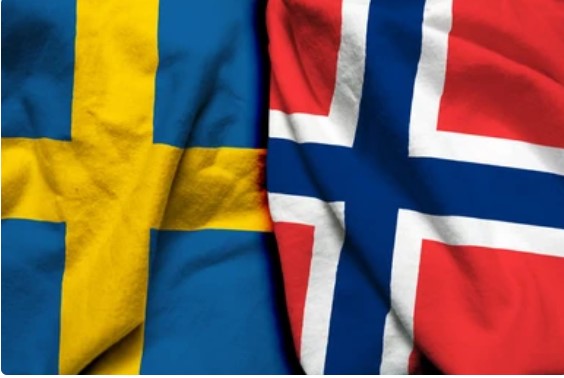
Should I Learn Norwegian Or Swedish
There are many languages to learn, and nobody has time to learn them all. So, if you have a vested interest in Scandinavia, you may be wondering if you should spend your time learning either Norwegian or Swedish. There are many answers to this question, so let’s take a look.

Key takeaways
- What language to learn depends on your goals
- For a general interest in Scandinavia, choose Norwegian
- For work related reasons, learn Swedish
- Both languages are similar and easy for English speakers to learn
- Norwegian is a bit easier
- Swedish has more international reach
- Norwegian has larger reach in Scandinavia
Should You Learn Norwegian Or Swedish?
Let’s be up front here. We are a Norwegian school, so of course we are biased towards Norwegian. But we’ll try to be as objective as possible in helping you answer this question.
There are many factors to consider, such as personal reasons, professional reasons, reasons relating to travel and what resources you have at your disposal. So let’s take a look and see which one of the two you should learn.
How To Choose Between Norwegian And Swedish?

We’ve split our arguments into four different camps to help you decide which of the two languages is most deserving of your time. Read on and see which ones apply to you and if that helps you narrow down your choice.
Personal Reasons
If you have a personal interest in either of the two countries, then the choice should be clear. If you’re a Norwegianofile then you should learn Norwegian. And if your heart beats the yellow and blue of Sweden, then by all means learn Swedish.
The same applies if you have family or friends in either one of the countries. Having Swedish friends and deciding to learn Norwegian is an odd choice. So go for the language that makes the most sense here.
If, however, you have more of a general interest in Scandinavia, and not particular interest in either country, then we would recommend Norwegian. Not only is Norwegian touted as being one of the easiest languages to learn for English speakers (Swedish is not far behind, to be fair), but it will also help you communicate with Swedes.
We like to say that Norwegian is the middle child of Scandinavia. By this we mean that it’s in the middle of Swedish and Danish. So learning Norwegian will allow you to communicate with not only other Norwegians, but also Swedes and Danes. Learning Swedish will help you communicate with Norwegians, but it does not have the same carry over to Danish.
Professional Reasons
Moving to Scandianvia for work may be a goal for you. After all, Scandinavian countries have some of the best ratings when it comes to work/life balance, equality, and wages. So why wouldn’t you want to work there? Sweden comes out on top here though.
Internationally speaking, Sweden is the bigger of the two countries. There are plenty of international companies (Volvo, IKEA, Spotify, H&M etc.) that require plenty of foreigners. Naturally the language will then also be more useful in international business.
The country also has a bigger population than Norway (10.4 million vs. 5.4 million). So there will naturally be more job opportunities there. We can also assume that you won’t be fluent in either language before moving there, so how many English speaking jobs are available? A quick search gave us 223 English speaking jobs available in Stockholm vs. just 63 in Oslo.
Travel
Again, this depends on where you’re traveling. If you’re traveling to just Sweden or Norway, then learn some basics in that language.
But if you’re doing a Scandinavian tour, then we would again advize learning some Norwegian first. Yes there are more Swedish speakers, but if you add up Swedes, Danes and Norwegians, we are talking about over 21 million people.
Now take into account that you’ll be able to understand and speak (to a certain extent) with Swedes and Danes using your newfound Norwegian skills. You’ll have a much larger reach with Norwegian. Swedish, or Danish for that matter, does not give you the same access to all of Scandinavia, so the choice here is clear.
Language Learning Resources
No matter which language you decide to learn, you’ll be pleased to know that there are countless learning resources online and in your local library (probably).
Some are free, like some language learning apps, and some you’ll have to pay for. We would recommend checking out some of these apps, or other basic learning resources first. This will allow you to expand your vocabulary and learn the basics of the language and its grammar.
But, you’ll never be fluent if you don’t speak and throw yourself into situations where you need to use the language on the fly. That’s why we recommend a conversation class in your chosen language. There are plenty to choose from online, so a quick google search and reading some reviews will lead you to the right one.
If you’ve decided to learn Norwegian, why not check out our conversation courses here. You’ll be placed in a group of students around your skill level, and use the language to talk about everyday situations. We also have native speaking teachers to guide the conversation and help you out along the way!
Tired of scrolling through the internet for Norwegian grammar?
Start an organised Norwegian course now.
In order to learn fluent Norwegian, we need to repeat it and speak it several times before our brain learns it.
Learn that in our courses!
Comparing Norwegian Language And Swedish Language
No matter which language you decide to learn, you’ll find plenty of similarities between them. But you might also be surprised at some of the differences.
Similarities Between The Languages
For the most part, Swedes and Norwegians can understand each other. Both countries have a great variety in local dialects, so some dialects might be harder to understand though.
Why is that, you ask? Well, both languages belong to the North Germanic branch of the Germanic language tree. Meaning, they have both evolved from the same common roots. In this case, that is Old Norse, spoken by the vikings.
Over the centuries they have evolved into their own distinct languages, but they are still similar enough to where mutual intelligibility is possible.
Differences Between The Languages
Turning now to the differences, we see how the centuries have separated the languages.
Though much of the vocabulary is similar, you will also find plenty of words that don’t exist in the other language. One reason for this is because of both languages’ love of loanwords from other languages.
Norwegian borrows many words from English, while Swedish has more loanwords from French or German.
The pronunciation in each language is also different. Norwegian vowels, for example, are more rounded than Swedish ones. Variations in a tonal pitch can change the meaning of a word in Swedish, while Norwegians like to stress syllables instead. Additionally, given the higher number of diphthongs, Norwegian has a more melodious sound than Swedish.
Either way, as an English speaker, you’ll find both languages relatively easy to learn. But given the higher amount of overlap between Norwegian and English, it might be a tad easier to learn.

What Are The Benefits Of Learning Norwegian Or Swedish?
There will be many benefits of learning either Norwegian or Swedish (or both for that matter), but they vary between the languages.
Benefits Of Learning Norwegian
Speaking Norwegian will allow you to understand the other Scandinavian languages. You can communicate with people in Sweden and Denmark using your Norwegian, and you’ll be able to understand them too. This does not work the other way around however. So if your goal is to have the largest reach, then go for Norwegian.
Norwegian is also one of the easiest languages to learn for English speakers. The FSI ranks Norwegian as a category 1 language, which means you’ll need around 24-30 weeks, or 600-750 hours of study to reach professional level proficiency.
Benefits Of Learning Swedish
Swedish is the larger of the two countries. Not only in terms of population, but also international reach. With its many international companies, Sweden has a larger reach out there in the rest of the world. So you might find it a more helpful language.
Learning Swedish will also allow you to communicate with Norwegians, though not with Danes. Norwegians can all, for the most part, understand Swedish, so you can get by pretty much anywhere in Norway speaking only Swedish.
It’s worth noting that, like Norwegian, Swedish is another category 1 language according to the FSI. Though, it might be a bit on the higher end of the category 1 spectrum than Norwegian is.
Learn fluent Norwegian from your level
Check your level now, and find the right course for you
Our classes has native Norwegians who knows how it feels to learn a language, and will do everything to help you.
Other Scandinavian Languages To Consider
But Swedish and Norwegian are not the only Scandinavian languages. What about the others?
Danish
At first glance, Danish seems very similar to Norwegian. And in some sense it is. The written language is almost exactly the same as Norwegian. This is because Denmark ruled over Norway for 400+ years, thereby affecting the way Norwegian was spoken and written.
But, if we look at the pronunciation, Danish becomes much more difficult. Danes tend to swallow the ends of words, and wont pronounce words in the same way as they are spelled. So learning Danish means having to learn the pronunciation and how this differs from how words are written.
Toughest Scandinavian Language
When we talk about Scandinavian languages, we tend to only think about Norwegian, Swedish and Danish, but there are actually two more. Icelandic and Faroese. These languages are also North Germanic ones and qualify as Scandinavia.
These two languages are much more difficult to learn for English speakers though. Given their relative isolated positions away from mainland Scandinavia, these languages have not had the same common trajectory as the rest of the Scandinavian ones, and as such the pronunciation, grammar, and vocabulary vary much more.
Which Languages Are Worth Learning?
Any language might be worth learning depending on your goals. Like we’ve stated, if you’re moving to a particular Scandinavian country, or have a specific interest in one of them, then learning that language is absolutely worth it.
Otherwise, you can make an argument that every language is worth learning. But, like has been stated above, Norwegian will allow you to not only understand and speak with other Norwegians, it will also allow you to understand a lot of Danish and Swedish too, and they will understand you. So why not go for the 3-in-1 deal?
Learning Tips And Strategies For Norwegian And Swedish
Now that you’ve decided which language you should learn, let’s take a look at some helpful strategies that will get you to fluency in no time.
How To Approach Learning A New Language
Firstly, you need to realize that it will take time. Even though Norwegian and Swedish are some of the easier languages to learn as an English speaker, it will still require time and dedication.
So set some realistic goals for yourself. Make a timeline on where you want to be in a few weeks time, and then some months. Making goals for yourself along the way is a great way to feel a sense of accomplishment, and also measure your progress.
You will also want to immerse yourself in the language and culture. Don’t worry if you don’t live in either country, as you can listen to podcasts or music in your chosen language. Try to find some TV-shows or movies to watch in the language, or set your Netflix subtitles to either Norwegian or Swedish as you watch your favorite shows.
Lastly, find speaking partners. You won’t become fluent if you never use the language in real life situations. So either find someone to practice with, or join an online class to help you speak. This will also make you more accountable, as you’ll force yourself to show up regularly and do what you need to do.
Tips For Learning Norwegian or Swedish
As a starter you need to find some basic teaching resources. You can check out a language learning app like Duolingo or Babbel. They will teach some vocabulary, get you familiar with pronunciation and basic grammatical structure.
We also offer a basic intro course in Norwegian. Check it out here. Then, when you feel like you’ve got the basics down, it’s time to put it into practice. Find someone to speak with in order to use the language as you would in a real situation. This is an absolutely necessary step. Why not join one of our Norwegian conversation classes here?

You also need to make sure you practice every day. Doing a little every day will ensure you remember the things you go over.
Learn fluent Norwegian in 4 months. Start today.
Did you know that you don’t need all the grammar to speak fluent Norwegian? In our classes we focus just on the necessary vocabulary. So you can learn 3 times faster.
Frequently Asked Questions About Learning Norwegian Or Swedish
Should I Learn Norwegian Or Swedish?
It depends on your goals. Swedish has a larger population and larger international reach. But Norwegian gives you greater access to Scandinavia as a whole because it allows you to communicate with Swedes and Danes too.
Can Swedes understand Norwegian?
Yes. For the most part Swedes will be able to understand the basic Norwegian dialects.
Learn fluent Norwegian in 4 months. Start today.
Did you know that you don’t need all the grammar to speak fluent Norwegian? In our classes we focus just on the necessary vocabulary. So you can learn 3 times faster.

